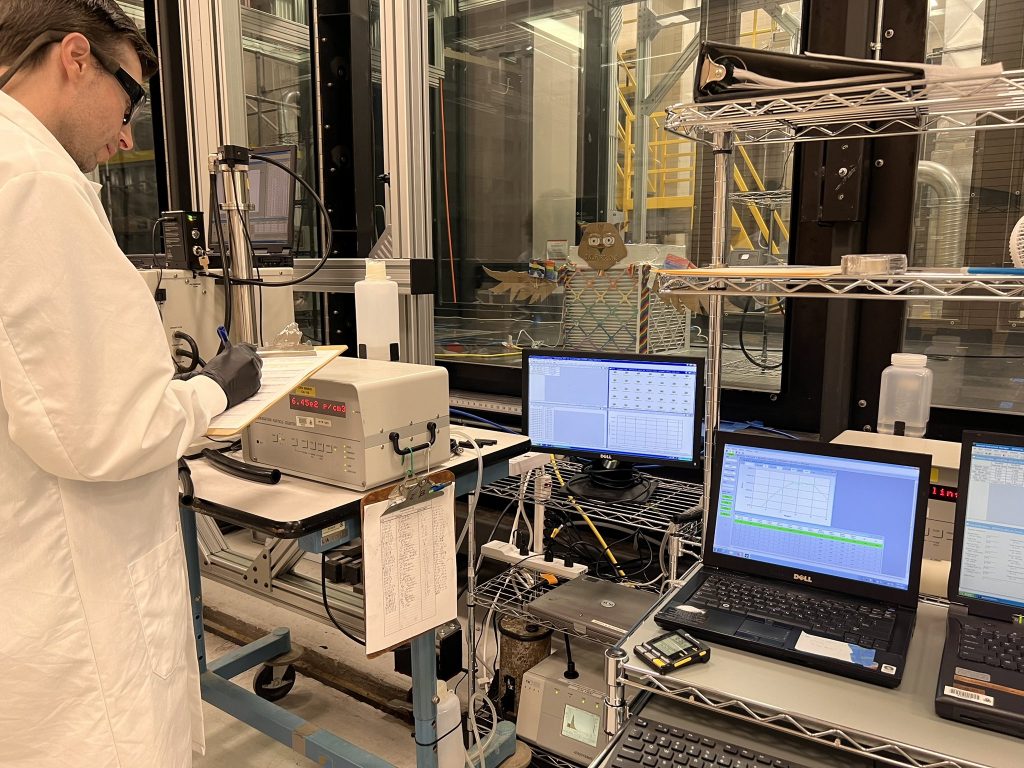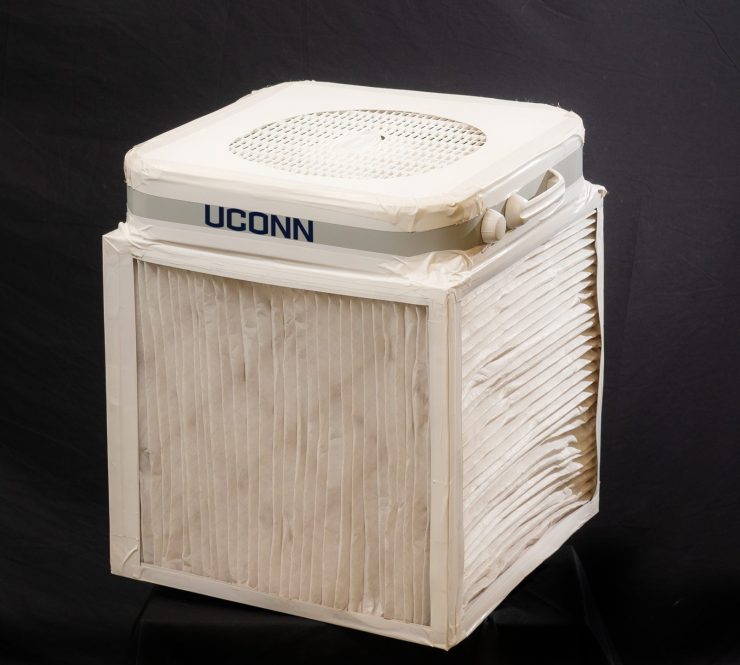Several years of community service and real-world research of the cross-campus UConn Indoor Air Quality Initiative has led to the awarding of $11.5 million in state support to UConn to bring access to low-cost, do-it-yourself “Corsi-Rosenthal” air-purifiers to every individual public school classroom in Connecticut.
On October 22 the State Bond Commission in Connecticut approved funding for the UConn Indoor Air Quality Initiative to administer and implement the purchase of equipment and materials for the construction and installation of individual classroom air purifiers. The state funding awarded to UConn will be part of SAFE-CT: Supplemental Air Filtration for Education Supplemental under the Clean Air Equity Response Program.
“We are pleased to offer these inexpensive devices to all classrooms across Connecticut,” says the Director of the UConn Indoor Air Quality Initiative, Marina Creed, an APRN who also serves UConn Health as a neuroimmunology nurse practitioner. “When schools, students, and teachers run one of these inside their classrooms it will reduce their exposure to viruses and bacteria, reducing the risk of disease transmission, meaning they are less likely to get sick.”
Creed adds, “Thank you to the Governor, Lieutenant Governor, and General Assembly for putting the health of our students and teachers first.”
Although these devices are created simply with just $60 of hardware store materials, they have been shown to be incredibly effective. The EPA and UConn jointly tested the devices in the EPA’s large bioaerosol test chamber, and results showed that in just 60 minutes it effectively removes over 99 percent of airborne viruses including the virus that causes COVID-19. Plus, recently published collaborative research findings by UConn and Arizona State University also show that DIY air purifiers work better than commercial HEPA air cleaners for a fraction of the cost.

“Our scientific results are huge!” says Creed, who also serves as an instructor of neurology at UConn School of Medicine. “These air purifiers immediately improve indoor air quality, which has been shown to decrease student absences from asthma and respiratory illness such as influenza, COVID, and RSV, and is also associated with improved academic performance including test scores.”
In 2021, UConn launched its cross-campus community service initiative during the pandemic to battle the COVID-19 virus with faculty, students, and staff volunteering to build and donate over 700 of the public health intervention tools to public schools and other community settings like the Veteran’s Administration (VA) Medical Center. The UConn Indoor Air Quality Initiative was initially started by Creed as an effort to better protect her immunocompromised multiple sclerosis patients and other vulnerable people in the community. Since that time, the reach of the Initiative has greatly expanded. In fact, building and testing the air filters has become part of a UConn Engineering class curriculum (ENGR 1166) as a public service learning project.
Creed’s Initiative co-collaborators at UConn are Kristina Wagstrom, Ph.D. of the College of Engineering and Misti Zamora, Ph.D. of the School of Medicine.
“We look forward to working with students from kindergarten through university-levels to provide opportunities for hands-on learning and engagement about solutions to improve indoor air quality,” shared Wagstrom, an associate professor in Chemical and Biomolecular Engineering in the College of Engineering at UConn-Storrs who specializes in improving estimates of the human and ecosystem health impacts of air pollution.
“We are excited to be able to use our experiences and expertise to help improve indoor air quality in Connecticut’s schools. This is more than a work project for us. It is very personal since many of our team have children attending schools in Connecticut, and we know how sensitive children can be to the air they breathe,” shares Zamora, an expert in assessing air quality and how it impacts our bodies who serves as an assistant professor in Public Health Sciences at UConn School of Medicine.
The Power of UConn and a Little Girl’s Letter

Eniola Shokunbi, an elementary school student in Middletown, wrote and mailed UConn Health a letter inviting them to her public school to help her class build an air purifier device. The student wanted to have UConn’s help to build these air filters to improve her nearly 100-year-old school’s indoor air quality, reduce her fellow students’ risk of illness, and also run her own science experiment testing the effectiveness of the devices across classrooms by tracking sick absences.
The inexpensive, build-it-yourself “Corsi-Rosenthal” box air purifiers have become part of a national movement during COVID-19 to help everyone more easily remove unhealthy air particles from indoor community settings, and even during national wildfire poor air-quality events. The movement has grown from the West Coast creators of the device at the University of California-Davis (Richard Corsi, dean of engineering at UC California-Davis, and Jim Rosenthal, CEO of Texas-based company Tex-Air Filters) all the way to the East Coast’s University of Connecticut.
UConn researchers were instrumental in taking the air filters on a road trip first to the White House’s Office of Science and Technology Policy and then for testing by the U.S. Environmental Protection Agency’s (EPA) Homeland Security Division Laboratory at the EPA’s Office of Research and Development in Research Triangle Park, North Carolina for high-tech, advanced biochamber research testing of the device. For two weeks the EPA scientists tested the efficacy of the low-cost DIY device against the non-pathogenic bacteriophage MS2, a surrogate virus for SARS-CoV-2, the virus that causes COVID-19. The team of EPA scientists led by Katherine Ratliff showed that the box removes 97% of infectious aerosols in just 30 minutes, and 99.4% within 60 minutes including the surrogate virus for SARS-CoV-2, the virus that causes COVID-19.
The UConn Indoor Air Quality Initiative’s cross-campus collaborators include UConn Health and its Comprehensive Multiple Sclerosis Center, UConn School of Medicine and its Department of Public Health Sciences, UConn College of Engineering, UConn School of Nursing, Connecticut Area Health Education Center Network (CT AHEC), UConn Neag School of Education, and Connecticut Children’s.
You can learn how to build your own simple, affordable DIY air cleaner with UConn’s simple online directions whether for your home, your classroom, or community setting. Also, view a how-to video by UConn College of Engineering students.



